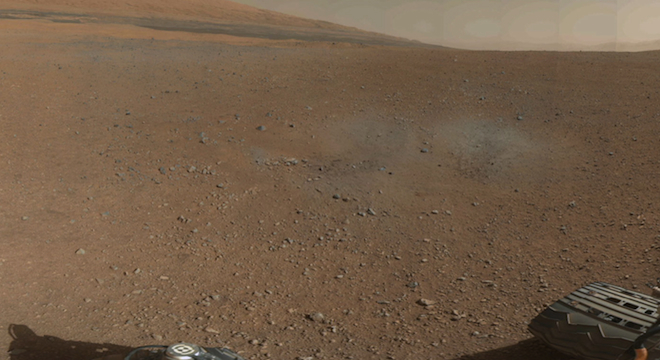The Mars Curiosity Rover’s surroundings on the Red Planet are becoming clearer to scientists and the rest of us back on Earth, thanks to a series of new high-res images the rover has taken of its landing site, which NASA published online Thursday.
Along with those, the rover has compiled a new series of hi-res images of itself, revealing some unexpected side-effects of its perilous landing on Monday, which involved an abrupt deceleration from 13,000-miles-per-hour to zero.
“We had another fantastic day on Mars and Curiosity continues to behave flawlessly,” said Michael Watkins, manager of the navigation and mission design section of NASA’s Jet Propulsion Laboratory in Pasadena, California, in a public briefing live-streamed on NASA’s website Thursday afternoon.
Evidence of the robotic vehicle’s excellent performance so far came in the form of a series of new composite imagery, including the first full-color 360-degree full-color panoramic view of the landing site, just a few miles outside of Gale Crater — a massive 96-mile-wide depression where NASA scientists believe liquid water may have been retained in ancient Mars. Click on the slice below to view the full 360-degree composite imagery.

In the distance of the panorama lies the rim of the crater, a series of dunes and mountainous features. In the middle-foreground to the left and right of the image are gray spots that NASA scientists think were likely caused by the rover’s landing craft thrusters firing close to the ground. The shots were taken with the rover’s 34-millimeter mast camera, or Mastcam, two identical cameras on the craft’s 3.6-foot-tall mast that can take stereoscopic imagery as well as video, the first files of which are expected soon.
The new 360-view comes on the heels of a similar panorama shot in black-and-white released earlier.
Another full circle of imagery was released by NASA on Thursday — this time of the rover itself, and in black and white.

These eight shots — stitched together to create a single uninterrupted view of Curiosity standing on the surface of the Red Planet — were taken by the rover’s twin navigation cameras, or Navcam, which are capable of capturing 3D images. Watkins pointed out that when zoomed in on the center of the rover, there are clearly visible pebbles resting on its body — the dark gray spots. Watkins said that these were “apparently kicked up by landing event,” and while they “pose no problems for operations” and there is no “operational constraint” by them being there, NASA scientists didn’t expect the landing to displace the rocks this way.
Watkins said that aside from snapping riveting new high-resolution imagery using some of its 17 cameras, the rover on Wednesday also passed all of its equipment check-outs and planned activities. The rover’s two-year-long science mission won’t actually kick-off until next week, after further tests and upgrades are performed.
Curiosity is due to receive a major software update on Saturday that will change the rover’s operating system from one designed specifically to accomodate its entry, descent and landing phases, to one designed for surface-level scientific exploration, including driving toward the nearby crater. Specifically, scientists intend to use Curiosity to study the Martian geology through the ages, evident in a 3.4 mile-high mountain in the crater known as Mount Sharp.
“It’s just like upgrading your operating system on your home computer,” Watkins explained.
The NASA Mars Curiosity rover, a $2.5 billion mission also known as the Mars Science Laboratory, is designed to determine from the Martian geology and chemical composition whether Mars ever had conditions capable of supporting carbon-based microbial life. The rover itself is the most advanced and physically largest ever launched by NASA, weighing nearly 1 ton and measuring 10-feet long, 9-feet wide and 7-feet tall, about the size of a compact SUV.






